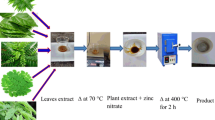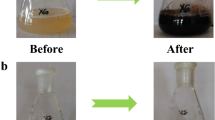Abstract
Ecofriendly nanoparticle synthesis is an ongoing worldwide effort to treat many human diseases. In the present study, Punica granatum peel extract is a reducing agent for green synthesizing silver nanoparticles (AgNPs). Further partially characterized by preliminary phytochemical screening, UV–visible spectroscopy analysis, Fourier-transform infrared spectroscopy (FT-IR) and gas chromatography–mass spectroscopy analysis (GC–MS). AgNPs potential was confirmed by in vitro antidiabetic activity, and its ability to inhibit carbohydrate digesting enzymes. AgNPs showed the least inhibition of enzymes with the highest value of 84.0% at 20 mg/ml, 79.0% at 20 mg/ml concentration of α-amylase and α-glucosidase enzyme activity, respectively. The enzymatic assay results revealed the existence of AgNPs can exhibit the dose-dependent inhibition on α Amylase enzyme α-glucosidase potentials. Our results suggest that P. granatum peel extract contains (AgNPs) a good antidiabetic agent against the key enzymes involved in diabetes. Hence, moral activity can be used to make appropriate nanomedicines and pharmaceutical industries.






Similar content being viewed by others
References
Min Y, Caster JM, Eblan MJ, Wang AZ (2015) Clinical translation of nanomedicine. Chem Rev 115:11147–11190
Ge L, Li Q, Wang M, Ouyang J, Li X, **ng MMQ (2014) Nano silver particles in medical applications: synthesis, performance, and toxicity. Int J Nanomed 9:2399–2407
Mirza AZ, Siddiqui FA (2014) Nanomedicine and drug delivery: a mini review. Int Nano Lett 4:94–99
Uchegbu IF, Schatzlein AG (2010) Burger’s medicinal chemistry, drug discovery and development, 7th edn. Wiley, Hoboken
Guariguata L, Whiting DR, Hambleton I, Beagley J, Linnenkamp U, Shaw JE (2014) Global estimates of diabetes prevalence for 2013 and projections for 2035. Diabetes Res Clin Pract 103:137–149
Exteberria U, De La Garza AL, Campin J, Martínez JA, Milagro FI (2012) Antidiabetic effects of natural plant extracts via inhibition of carbohydrate hydrolysis enzymes with emphasis on pancreatic alpha amylase. Expert Opin Ther Targets 16:269–297
Albrecht M, Jiang W, Kumi-Diaka J, Lansky EP, Gommersall LM, Patel A, Mansel RE, Neeman I, Geldof AA, Campbell MJ (2004) Pomegranate extracts potently suppress proliferation, xenograft growth and invasion of human prostate cancer cells. J Med Food 7:274–283
Jainendra Kumar B, Narender B, Vasudha B (2017) Phytochemical screening and evaluation of anti-emetic activity of Punica granatum leaves. Eur J Pharm Med Res 4:526–532
Howell AB, D’Souza DH (2013) The pomegranate: effects on bacteria and viruses that influence human health. Evid-Based Compl Altern Med 60:212–221
Lansky EP, Newman RA (2007) Punica granatum (pomegranate) and its potential for prevention and treatment of inflammation and cancer. J Ethnopharmacol 109:177–206
Sharma P, McClees SF, Afaq F (2017) Pomegranate for prevention and treatment of cancer: an update. Molecules 22:177–182
Amakura Y, Okada M, Tsuji S, Tonogai Y (2000) High-performance liquid chromatographic determination with photodiode array detection of ellagic acid in fresh and processed fruits. J Chromatogr A 896:87–93
Al-Zoreky NS (2009) Antimicrobial activity of pomegranate (Punica granatum L.) fruit peels. Int J Food Microbiol 134:244–248
Khan SA (2009) The role of pomegranate (Punica granatum L.) in colon cancer. Pak J Pharm Sci 22:346–348
Yousef MS, Abdelhamid HN, Hidalgo M, Fathy R, Gómez-Gascón L, Dorado J (2021) Antimicrobial activity of silver-carbon nanoparticles on the bacterial flora of bull semen. Theriogenology 161:219–227
Debiyi OO, Sofowora FA (1978) Phytochemical screening of medical plants. Ilyoidia 3:234–246
Mubail A, Chatterji S, Rai PM, Watal G (2012) Evidence based green synthesis of nanoparticles. Adv Mater Lett 3:519–525
Basu A, Penugonda K (2009) Pomegranate juice: a heart-healthy fruit juice. Nutr Rev 67:49–56
Raskin I, Ribnicky DM, Komarnytsky S, Llic N, Poulev A, Borisjuk N, Brinker A, Moreno DA, Ripoll C, Yakoby N (2002) Plants and human health in the twenty-first century. Trends Biotechnol 20:522–531
Kumar A, Vijayalakshmi K (2013) In vitro antimicrobial activity & phytochemical analysis of selected fruit wastes. Int J Curr Microbiol Appl Sci 2:196–204
Tahsin B, Vaishali J, Geetanjali TB, Zinjarde S (2020) Gold nanoparticles biosynthesized by Nocardiopsis dassonvillei NCIM 5124 enhance osteogenesis in gingival mesenchymal stem cells. Appl Microbiol Biotechnol 104:4081–4092
Etxeberria U, De La Garza AL, Campin J, AlfredoMartínez J, Fermín IM (2012) Antidiabetic effects of natural plant extracts via inhibition of carbohydrate hydrolysis enzymes with emphasis on pancreatic alpha amylase. Expert Opin Ther Targets 16:269–297
Nickavar B, Abolhasani L (2013) Bioactivity-guided separation of an α-amylase inhibitor flavonoid from Salvia virgata. Iran J Pharm Res 12:57–61
Banihani S, Swedan S, Alguraan Z (2013) Pomegranate and type 2 diabetes. Nutr Res 33:341–348
Acknowledgements
The authors are thankful to the authority of Idhaya College for Women, National College (Autonomous) and Annamalai University for providing necessary facilities and support.
Author information
Authors and Affiliations
Corresponding author
Ethics declarations
Conflict of interest
The authors declare that they have no known competing financial interests or personal relationships that could have appeared to influence the work reported in this paper.
Humans and animals rights
This manuscript does not contain research involving humans and animals.
Additional information
Publisher's Note
Springer Nature remains neutral with regard to jurisdictional claims in published maps and institutional affiliations.
Rights and permissions
Springer Nature or its licensor holds exclusive rights to this article under a publishing agreement with the author(s) or other rightsholder(s); author self-archiving of the accepted manuscript version of this article is solely governed by the terms of such publishing agreement and applicable law.
About this article
Cite this article
Saminathan, U., Ramasamy, P., Chinathambi, A. et al. Synthesis, characterization of silver nanoparticles from Punica granatum L. and its in vitro antidiabetic activity. Nanotechnol. Environ. Eng. 7, 923–930 (2022). https://doi.org/10.1007/s41204-022-00278-6
Received:
Accepted:
Published:
Issue Date:
DOI: https://doi.org/10.1007/s41204-022-00278-6




